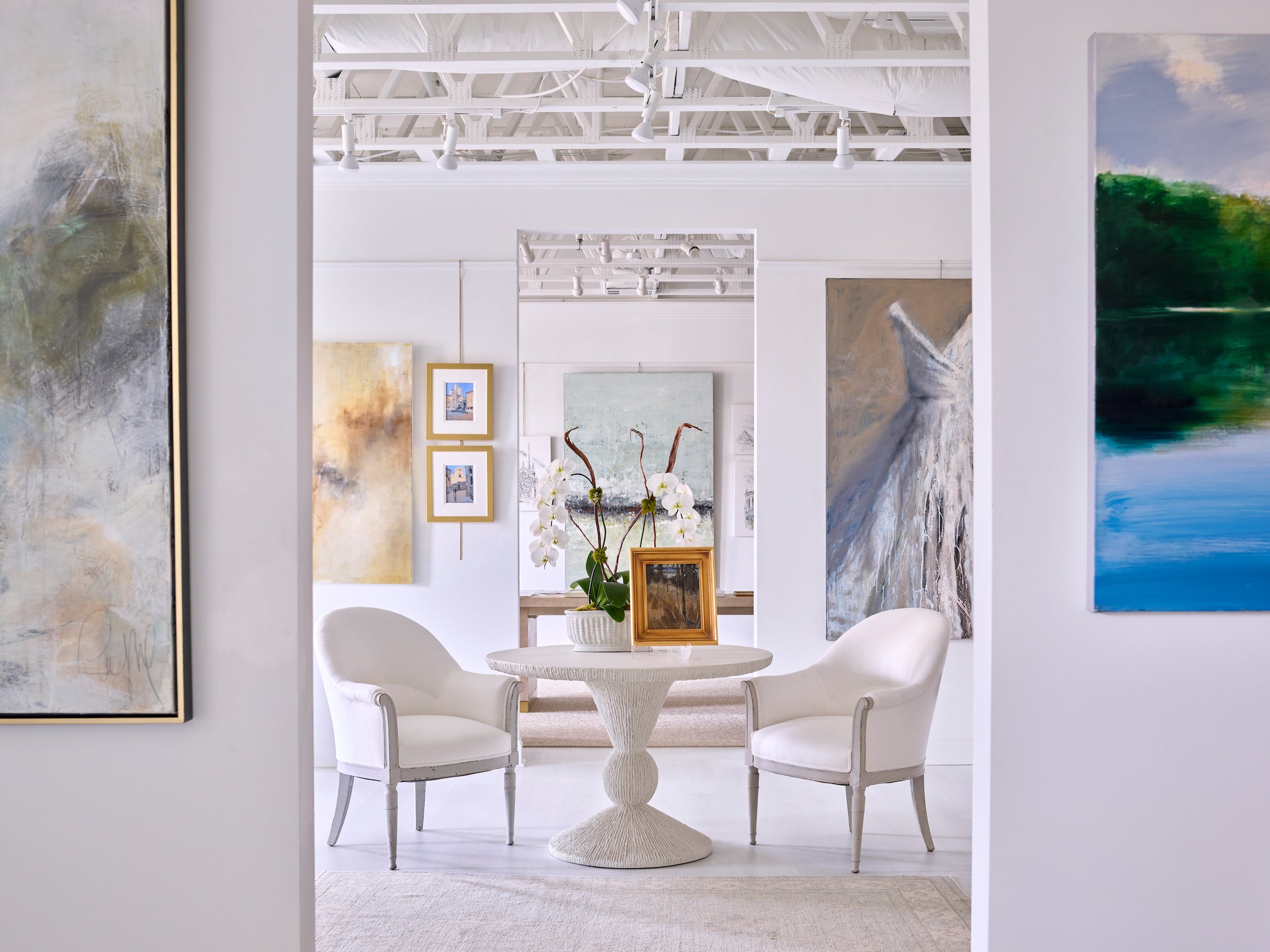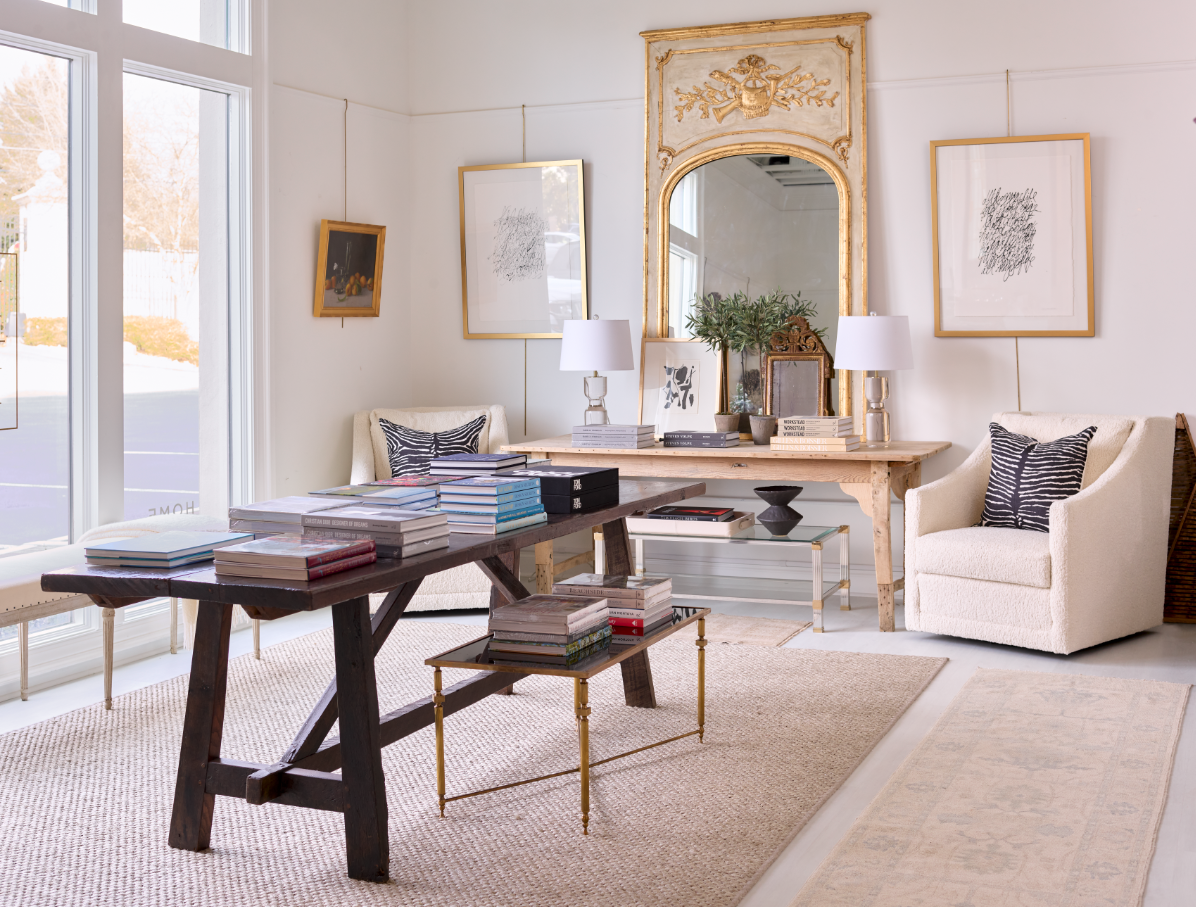As we spend more time in our homes these days, it’s not surprising that our art gallerists, especially Linda and Mackenzie, have been busier than ever. Lots of people are interested in filling their walls right now, whether it’s starting a collection of fine art or getting help moving their existing collections around their homes. So we thought this might be a good time to revisit the interview questions we received several years ago from a local publication about how to purchase and care for art.
What are the main components in terms of building and displaying an at-home art collection?
Buy what you love! We always advise our clients to purchase paintings that speak to their hearts. Matching a sofa or paint color is fine, but in the long run, the painting you love with a passion will be the one you constantly gravitate to.

This painting, one of my favorites, spoke to me from the dust-filled window of a crumbling antique store in Belgium, and I just had to have it!
In terms of preservation, what should at-home art collectors consider?
We suggest using a reliable framer who incorporates archival materials and guarantees his work. We like to use UV-protected or museum-quality glass on our watercolors and gouaches (like the Charles Ross work on paper, below). Keeping artwork out of direct sunlight is also advisable, although canvases painted with oil or acrylic paint are quite resilient. Encaustic paintings (those created with a wax-based medium) should be kept in a climate-controlled environment.
Please list five unconventional spaces that can be used for an unconventional gallery, a long hallway or foyer, for example?
Our guide is always to put things where you will enjoy them. So if you spend time at your kitchen sink, hang one of your favorite paintings so you can see it. Or if you like to sit and read in a chair, hang a painting low so that you can appreciate it from your chair. If you spend a lot of time at your desk, put one of your favorite paintings on a little easel. Mudrooms, powder baths, closets and stairwells are other spaces that are frequently overlooked. There are no rules except to hang art where you can most appreciate it, like in the Conti apartment below, where we hung a wonderful painting purposefully low.

What is the most important consideration when starting an at-home collection?
Start by purchasing only paintings that you love. Educate yourself, visit galleries and ask questions. Read up on artists that interest you. And if you have a chance to meet the artist, like our wonderful Pascal Bouterin doing a demo at the gallery, don't miss it!
What art gallery elements can and should be incorporated at home?
You can learn a lot from galleries in terms of how to frame, hang and light a collection. Ask questions at your favorite galleries and be aware of how they hang groupings or display artists. We also suggest taping the artist’s bio – or any other information about the painting – to the back of the canvas for future reference.

Mackenzie at her desk and ready to answer your questions!
What is your advice to novice collectors who may be intimidated by purchasing art, and the art world in general?
We totally understand that purchasing art can be intimidating – and we try very hard make everyone feel welcome and comfortable our gallery and home store. Our rules are fairly simple: If you love it, it will work. If you are intrigued by it, and you believe in the artist, you will probably grow to love it. Work with a gallery that you trust, and let them guide you gently down that path of discovery. The process will be a little intimidating, then exciting and then reassuring and hopefully exhilarating!
 The unintimidating and friendly duo, Mackenzie and Linda with a Kelley Ogburn painting
The unintimidating and friendly duo, Mackenzie and Linda with a Kelley Ogburn painting
Are there any rules to follow when integrating art into one’s living spaces?
If you buy what you love, and not for a space, there really are no rules to follow – except: place the art where you will enjoy it everyday. Don’t be afraid to mix it up and move it around. Don’t treat your paintings as precious commodities. They should be loved and enjoyed on a daily basis! (In my kitchen, below, I rotate a different painting over this key sink area every couple of months because why not make dishwashing a most enjoyable activity?)
 Even though “good art” is largely subjective, are there certain elements common to all pieces of “fine art”?
Even though “good art” is largely subjective, are there certain elements common to all pieces of “fine art”?
Yes, there are many keys to good paintings such as a balanced composition, a confident brushstroke, a strong sense of light and color, original or creative treatment, accurate perspective and many other technical elements that make up a good painting. A gallery should be able to inform you of these elements when you’re considering a painting. Again: don’t be afraid to ask questions.  We value a confident brushstroke, like that of Laura Lacambra Shubert's work
We value a confident brushstroke, like that of Laura Lacambra Shubert's work
Is there any place inside the home where art should never be hung? If so, why?
No! Place it where you will appreciate it everyday, even if that means the bathroom, closet, the exercise room or at eye level, next to your desk - or in the case of Cremant apartment, in the fireplace!

Is it advisable for at-home collectors to incorporate contemporary artwork into traditional interiors or vice versa? Why or why not?
We love the idea of mixing painting styles and purposely hang that way at our gallery. At home, we think this is the first clue that you are a serious and committed art lover and collector. Not only does a variety of styles and media add great interest and depth to a collection, but it can reflect a natural evolvement of a collector’s personal taste. It all goes back to building a collection based on what you love.
 In my own home, I have this painting by Jazzu hanging across from a Dutch 19th C. artist. Talk about mix and not-match!
In my own home, I have this painting by Jazzu hanging across from a Dutch 19th C. artist. Talk about mix and not-match!

What is the proper way to handle, light, and hang a piece of art?
With great care! Paintings should be blanket wrapped or protected with bubble wrap and cardboard for transport. Anything with glass must be triple-wrapped to prevent breakage.
Paintings are best lit with incandescent spotlights, but a small portable spotlight trained strategically on the painting will work effectively, too. Natural daylight is always a plus. We’re also big fans of dimmers.
We like to hang our paintings at eye-level, often stacking the larger paintings over smaller ones or creating entire gallery walls - like the one below by designer Robert Brown featured in Atlanta Homes & Lifestyles. This is a great way to incorporate a number of favorite pieces as long as there is one element that ties them together (subject, medium, palette, framing). For do-it-yourselfers, paintings are easily hung at home with the appropriate size hanger, preferably nailed into wall studs. If you don’t want to tackle this yourself, ask the gallery for a recommendation on a professional installer.

From an emotional level, how can art enhance one's life?
Sam Jones, one of our long term employees at the store and gallery, has said it best: “Art can make you smile, laugh, cry, bring back memories, calm you down, perk you up, change your attitude, give you attitude, confuse you, inspire you, entertain you, transport you, perhaps even change your life....or at least the way you look at your life. Art should be your drug of choice. And it's a lot cheaper than therapy.”
Sam is passionate about art and we’re pretty sure she’s not in therapy! We echo her sentiment and can’t imagine the void our lives and culture would have without art in all its glorious forms.

Ta ta,
HH











 The unintimidating and friendly duo, Mackenzie and Linda with a
The unintimidating and friendly duo, Mackenzie and Linda with a  We value a confident brushstroke, like that of
We value a confident brushstroke, like that of  In my own home, I have this painting by
In my own home, I have this painting by 


